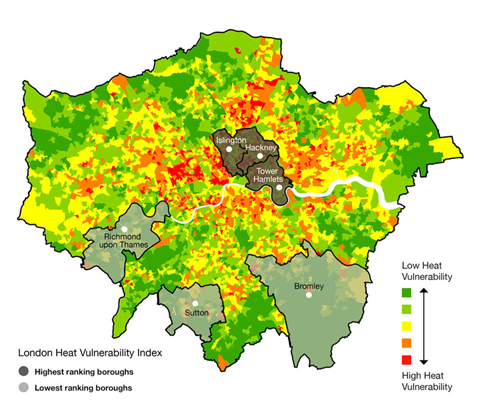A report by Arup looks at the impact of extreme weather events on urban populations, and points to ways we can help the most vulnerable

London was hotter than Miami towards the end of last month, and by 2050 hot weather like this will be a regular feature of summers in the capital. Major heat waves, like the one we experienced in 2003, used to be a once every two-decade event. Soon they will occur every three years. While there are positives to having hot weather in cities, it also presents urban areas with major challenges. So, how can our industry help cities like London adapt to a hotter climate, as well as other extreme weather events?
I’m part of a team working with cities to help them become more resilient. A major focus is helping them adapt to, and become better at managing the impacts of climate change. These will be felt through an increase in extreme weather events such as heat waves and floods. Crucially, it is often the most vulnerable people, particularly the elderly, in cities that will experience these impacts more intensely.
City dwellers currently represent 54% of the total world population. The world’s growing and urbanising population is also ageing. By 2050 people aged over 65 will comprise a fifth of the total world population and people aged over 80 will quadruple. Combined, these trends mean more people will be exposed and vulnerable to the impacts of climate change in cities.
Together with research partners University College London, King’s College London, Climate UK, HelpAge International and Satellite Applications Catapult, we recently published a report which looks at the impact of climate change and extreme weather events in London, New York and Shanghai. Specifically, we focused on the exposure and vulnerability of the ageing populations in these global cities.
Based on the resulting Heat Vulnerability Index, Hackney, Islington and Tower Hamlets were found to have the greatest number of high vulnerability areas
For London, we used satellite data to obtain surface temperature maps for the city. These revealed differences of up to 10oC between different areas during the 2003 heat wave, due to the “Urban Heat Island Effect”. We combined this data with socio-economic factors, including population density, health, mobility and quality of housing to understand where the population is most at risk.
Based on the resulting Heat Vulnerability Index, Hackney, Islington and Tower Hamlets were found to have the greatest number of high vulnerability areas, where older people are especially at risk from heat-related illnesses as the capital gets hotter. High temperatures present a particular risk to the elderly, as they are more susceptible to heat-related illnesses such as heat stroke and exhaustion. Heat waves can also exacerbate impairments associated with pre-existing health conditions such as asthma, heart disease and diabetes.

But the good news is that there are a wide range of “win-win” measures that can increase the resilience of elderly urban populations that have wider environmental, social and economic benefits. For example:
- Creating more green and blue infrastructure in and around new developments and within existing areas to increase cooling potential. Implementing shading of high streets, entrances to tube and train stations, bus stops and external spaces through tree planting and structures. Transforming grey surfaces to green, and impermeable surfaces to permeable. This also has benefits for water management, air quality and biodiversity
- Taking a “design for future climate and people” approach to new building, infrastructure and public realm projects. Integrating climate change projections and the needs of an ageing population into designs. We may need to start thinking about “silver infrastructure”, as well as green, blue and digital infrastructure, to support older people in cities, buildings and public spaces.
- Using passive design measures in new buildings and developments. Installing air conditioning in every new building is not the answer. It’s expensive and only exacerbates the problem we are trying to address due to the energy required, and the associated carbon and waste heat. Selected buildings may need to be able to switch on energy efficient, low carbon air conditioning during the hottest months, for the most vulnerable people. But most of us and most of our buildings can do without out it for most of the time.
The aim of our report is to create greater understanding and awareness of the risks of hot weather and other extreme weather events for the most vulnerable people in cities. Our work is part of a growing community of interest and expertise in this area.
Built environment professionals like us have an opportunity to help people cope with increasing extreme weather events, in ways which have wider resilience and efficiency benefits. Measures don’t have to be expensive or hi-tech. But our industry needs to think creatively about how to “do more with less” and start doing things now.
Polly Turton is a climate change adaptation consultant for Arup




























No comments yet